IARS2 Gene Cataracts Growth Hormone Deficiency Sensory Neuropathy Sensorineural Hearing Loss and Skeletal Dysplasia Genetic Test
At DNA Labs UAE, we offer the IARS2 Gene Cataracts Growth Hormone Deficiency Sensory Neuropathy Sensorineural Hearing Loss and Skeletal Dysplasia Genetic Test at a cost of AED 4400.0.
Test Components:
- IARS2 Gene Cataracts Growth Hormone Deficiency Sensory Neuropathy Sensorineural Hearing Loss and Skeletal Dysplasia Genetic Test
Price:
AED 4400.0
Sample Condition:
Blood or Extracted DNA or One drop Blood on FTA Card
Report Delivery:
3 to 4 Weeks
Method:
NGS Technology
Test Type:
Ear Nose Throat Disorders
Doctor:
ENT Doctor
Test Department:
Genetics
Pre Test Information:
Clinical History of Patient who is going for IARS2 Gene Cataracts, Growth Hormone Deficiency, Sensory Neuropathy, Sensorineural Hearing Loss, and Skeletal Dysplasia NGS Genetic DNA Test. A Genetic Counselling session to draw a pedigree chart of family members affected with IARS2 Gene Cataracts, Growth Hormone Deficiency, Sensory Neuropathy, Sensorineural Hearing Loss, and Skeletal Dysplasia NGS Genetic DNA Test gene IARS2.
Test Details:
The IARS2 gene is associated with a rare genetic disorder called IARS2-related disorder. This disorder is characterized by a combination of symptoms including cataracts (clouding of the lens in the eye), growth hormone deficiency, sensory neuropathy (damage to the nerves that transmit sensory information), sensorineural hearing loss (hearing loss caused by damage to the inner ear or auditory nerve), and skeletal dysplasia (abnormal bone development).
A Next-Generation Sequencing (NGS) genetic test can be used to analyze the IARS2 gene and identify any mutations or variations that may be present. This type of test can provide a comprehensive analysis of the entire gene, allowing for a more accurate diagnosis of IARS2-related disorder.
By identifying mutations in the IARS2 gene, healthcare professionals can confirm a diagnosis and provide appropriate medical management and genetic counseling for individuals with this disorder. Additionally, genetic testing can help determine the risk of passing on the condition to future generations and guide reproductive decisions.
| Test Name | IARS2 Gene Cataracts growth hormone deficiency sensory neuropathy sensorineural hearing loss and skeletal dysplasia Genetic Test |
|---|---|
| Components | |
| Price | 4400.0 AED |
| Sample Condition | Blood or Extracted DNA or One drop Blood on FTA Card |
| Report Delivery | 3 to 4 Weeks |
| Method | NGS Technology |
| Test type | Ear Nose Throat Disorders |
| Doctor | ENT Doctor |
| Test Department: | Genetics |
| Pre Test Information | Clinical History of Patient who is going for IARS2 Gene Cataracts, growth hormone deficiency, sensory neuropathy, sensorineural hearing loss, and skeletal dysplasia NGS Genetic DNA Test. A Genetic Counselling session to draw a pedigree chart of family members affected with IARS2 Gene Cataracts, growth hormone deficiency, sensory neuropathy, sensorineural hearing loss, and skeletal dysplasia NGS Genetic DNA Test gene IARS2 |
| Test Details |
The IARS2 gene is associated with a rare genetic disorder called IARS2-related disorder. This disorder is characterized by a combination of symptoms including cataracts (clouding of the lens in the eye), growth hormone deficiency, sensory neuropathy (damage to the nerves that transmit sensory information), sensorineural hearing loss (hearing loss caused by damage to the inner ear or auditory nerve), and skeletal dysplasia (abnormal bone development). A Next-Generation Sequencing (NGS) genetic test can be used to analyze the IARS2 gene and identify any mutations or variations that may be present. This type of test can provide a comprehensive analysis of the entire gene, allowing for a more accurate diagnosis of IARS2-related disorder. By identifying mutations in the IARS2 gene, healthcare professionals can confirm a diagnosis and provide appropriate medical management and genetic counseling for individuals with this disorder. Additionally, genetic testing can help determine the risk of passing on the condition to future generations and guide reproductive decisions. |







